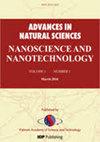Antibacterial activity of green synthesized ZnO nano-flower using pineapple peel extract
IF 2.1
Q3 MATERIALS SCIENCE, MULTIDISCIPLINARY
Advances in Natural Sciences: Nanoscience and Nanotechnology
Pub Date : 2023-05-17
DOI:10.1088/2043-6262/acd240
引用次数: 2
Abstract
Plant-based nanoparticles provide significant advantages over conventional physico-chemical techniques in medicine and biology. This paper reports the green route to synthesise ZnO particles using pineapple peel extract at various zinc precursor concentrations and evaluate their antibacterial activity. Morphological, structural, and optical properties of ZnO were characterised using SEM, XRD, FTIR, and UV–vis. The antibacterial potential of ZnO particles was evaluated against two clinical strains of Escherichia coli (E. coli) and Staphylococcus aureus (S. aureus) using the paper disc diffusion method. SEM images exhibit flower-like ZnO with diameters in the range of 331–538 nm. The hexagonal wurtzite crystal phase of ZnO has been confirmed by XRD analysis with a crystal size of 14–17 nm. The FTIR spectrum has also validated the Zn-O bonding and the presence of additional functional groups in the samples. Antibacterial activity of the nanoflower ZnO towards E. coli and S. aureus displays inhibitory zone widths of 17.23 ± 3.03 mm and 30.14 ± 1.86 mm, respectively. These findings reveal that nanoflower ZnO produced using the pineapple peel extract exhibited a large bacterial inhibition zone, indicating that it is potentially used as food packaging or antibiotics.菠萝皮提取物制备绿色ZnO纳米花的抗菌活性
基于植物的纳米颗粒在医学和生物学方面比传统的物理化学技术具有显著的优势。本文报道了用不同锌前驱体浓度的菠萝皮提取物合成氧化锌颗粒的绿色途径,并对其抑菌活性进行了评价。采用SEM、XRD、FTIR和UV-vis对ZnO的形貌、结构和光学性质进行了表征。采用纸片扩散法,对氧化锌颗粒对大肠杆菌(E. coli)和金黄色葡萄球菌(S. aureus)两种临床菌株的抑菌潜力进行了评价。SEM图像显示ZnO呈花状,直径在331-538 nm之间。XRD分析证实ZnO为六方纤锌矿晶相,晶粒尺寸为14 ~ 17 nm。FTIR光谱也证实了样品中存在Zn-O键和其他官能团。纳米花氧化锌对大肠杆菌和金黄色葡萄球菌的抑菌带宽度分别为17.23±3.03 mm和30.14±1.86 mm。上述结果表明,利用菠萝皮提取物制备的纳米花氧化锌具有较大的细菌抑制带,表明其具有潜在的食品包装或抗生素应用前景。
本文章由计算机程序翻译,如有差异,请以英文原文为准。
求助全文
约1分钟内获得全文
求助全文
来源期刊

Advances in Natural Sciences: Nanoscience and Nanotechnology
NANOSCIENCE & NANOTECHNOLOGYMATERIALS SCIE-MATERIALS SCIENCE, MULTIDISCIPLINARY
自引率
4.80%
发文量
0
 求助内容:
求助内容: 应助结果提醒方式:
应助结果提醒方式:


